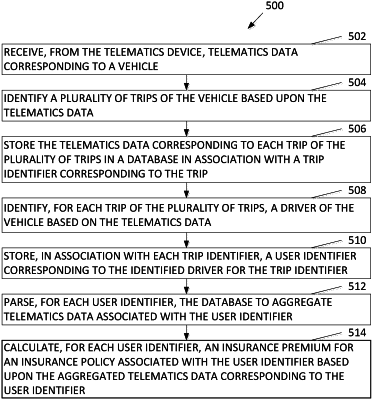| CPC G07C 5/0808 (2013.01) [G06Q 40/02 (2013.01); G06Q 40/08 (2013.01); G07C 5/008 (2013.01); G07C 5/085 (2013.01)] | 21 Claims |

|
1. A vehicle analytics (VA) computing device comprising a processor in communication with a memory device and a vehicle, the processor configured to:
receive, from telematics sensors associated with the vehicle, historical telematics data corresponding to the vehicle, the historical telematics data including historical sensor data collected from the vehicle;
generate, using the historical telematics data, a driver profile model for a user of the vehicle;
receive, from the telematics sensors, additional telematics data associated with a plurality of trips driven by the user using the vehicle;
train, using machine learning techniques and the additional telematics data, the driver profile model to identify patterns in driving behaviors of the user, the driving behaviors including a driving style of the user, routes driven by the user, and driving preferences of the user;
store, in a database, the trained driver profile model;
receive, from the telematics sensors, current telematics data associated with a trip taken by the vehicle;
identify the user as a driver of the vehicle during the trip by comparing the current telematics data to the trained driver profile model;
in response to identifying the user as the driver of the vehicle, output, from the trained driver profile model, (i) a driver profile of the user and (ii) driving recommendations for the user based upon the identified patterns for the user, the driving recommendations including recommendations for the user to improve driving behaviors associated with vehicle operation;
cause the driving recommendations to be displayed on a user device of the user; transmit a prompt to the user device to confirm that the user is the driver of the vehicle;
receive, from the user device, a confirmation indicating that the user is the driver;
reinforce the trained driver profile model for the user based upon the confirmation, the confirmation causing the VA computing device to add weight to the identified patterns when identifying the user as the driver; and
determine, based upon subsequent telematics data received from the telematics sensors, that the user followed the driving recommendations transmitted to the user device.
|